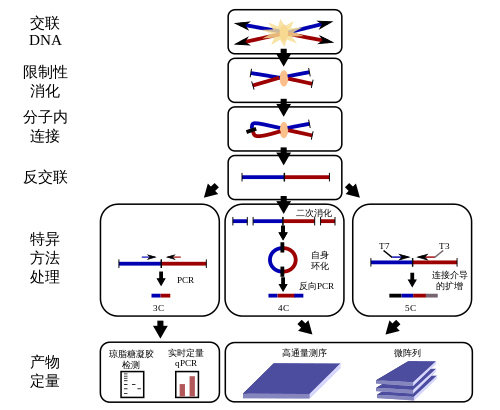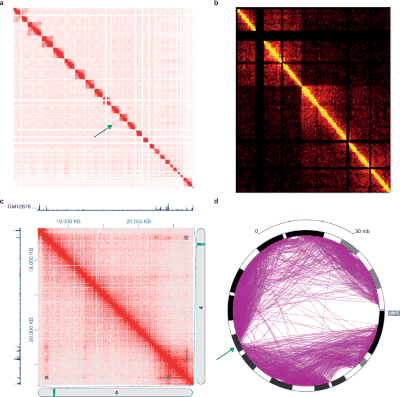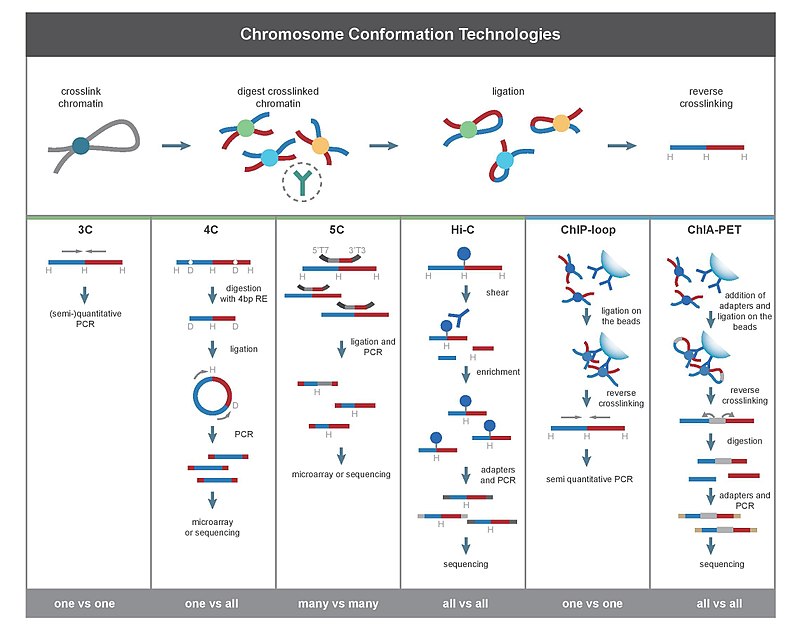染色體構象捕獲

染色體構象捕獲[1](英語:Chromosome conformation capture,簡稱為3C)是一種用於分析細胞自然狀態下染色體組織形式的高通量分子生物學技術。對於理解並評價基因調控、DNA複製和修復來說,研究染色體的結構性質和空間組織是尤為重要的。
影響基因表達的染色質相互作用的例子之一是:染色體區域摺疊可以將增強子及相關轉錄因子帶到基因附近,這一點首次在β-珠蛋白結構域中獲得證實[2]。染色體構象捕獲使得研究者們可以根據上述的細胞機制來研究對染色質活性產生影響的因素。這一技術對研究模式生物和人體中遺傳學及表觀遺傳學很有幫助。
基於原始的3C技術,現已發展出多項新的技術,這些技術可增加一條染色體與其它染色體及其它蛋白之間進行定量的通量。這些所有的3C相關的技術大致可被分為四類:(1)3C和ChIP版本的3C(ChIP-loop assay)、(2)4C和ChIP版本的4C(增強型4C)、(3)5C和3D檢測以及(4)基因組構象捕獲(GCC)相關技術(Hi-C)和ChIP版本的GCC(也被稱為6C)。在4C、5C和Hi-C中通過微陣列和高通量測序手段對DNA片段進行分析的應用使得對染色體交互作用的分析進入全基因組規模。
歷史[編輯]
很久之前, 顯微鏡學是研究細胞核結構[3]最主要的方法, 該方法最早可以追溯到1590 [4].

1879年,華爾瑟·弗萊明(Walther Flemming)首先命名了染色質[5]。
1883年,奧古斯特·魏斯曼(August Weismann)發現了染色質是主要遺傳物質。
1884年,阿爾布雷希特·科塞爾(Albrecht Kossel)發現了組蛋白。
1888年,Sutton和Boveri提出了染色質在細胞循環中是連續的理論[6]。
1889年,Wilhelm von Waldemeyer命名了染色體[7]。
1928年,Emil Heitz命名了異染色質和真染色質[8]。
1942年,Conrad Waddington首次假設了表觀遺傳結構的存在(epigenetic landscapes) [9]。
1948年,R. D. Hotchkiss發現了DNA甲基化[10]。
1953年,沃森和克里克發現了DNA的雙螺旋結構[11]。
1961年,瑪莉·里昂(Mary Lyon)提出了X染色體去活化的假設。
1973-1974年,染色質纖維(chromatin fiber)被發現[9]。
1982年,染色體領域(Chromosome territories)被發現[12]。
1984年,John T. Lis發明了染色質免疫沉澱技術。
2002年,Job Dekker及其同事發明了3C技術。
2003年,人類基因組計劃完成。
2006年,Marieke Simonis 發明了4C技術[13], 同年,Dostie 發明了 5C 技術[14]。
2007年,B. Franklin Pugh發明了染色質免疫沉澱-測序技術[15]。
2009年,Liebermann-Aiden發明了高通量染色體構象捕獲技術(Hi-C)[16], 同年,Melissa J. Fullwood發明了ChIA-pet技術. [17]。
2012年,Bin Ren實驗室發現並定義了拓撲相關結構域(Topologically Associated Domains,TADs) [18]。
實驗方法[編輯]
所有基於3C的方法都從相似的步驟開始。
步驟一: 交聯: 加入甲醛可以使 DNA 與蛋白或蛋白與蛋白之間相互粘結, 這樣會導致相互作用的 DNA 片段被交聯在一起. (for example cis located promoters to trans located promoters, reveals interactions like the interaction between H enhancer and odorant receptor promoters).
步驟二: 限制酶消化: 加入過量限制性內切酶將未交聯的 DNA 與交聯的 DNA 相互分離. 限制酶的選擇取決於需要分析的基因座位的情況. 限制序列較短 (4 bp) 的內切酶切點密集, 用於研究較短的座位 (< 10~20 kb), 而限制序列較長 (6 bp) 的內切酶用於研究較長的座位.
步驟三: 分子內連接:

在使用低劑量 DNA 底物的情況下, DNA 末端連結反應更偏好於將臨近的 DNA 片段連接而非隨機進行連接. 這種情況下, 兩類連接反應會更頻繁出現: 其一是限制酶未完全消化的 DNA 切口被重新連接, 這種情況大致佔全部接口的 20% 到 30%, 此類連接與染色質構象捕獲實驗無關, 我們可以通過降低第一步交聯反應的緊密程度來減少這類反應; 另一類頻繁發生的連接反應是同一分子內的 DNA 的末端由於距離較近被連接, 這樣的接口佔到了全部接口的 30% 左右, 這類連接也會發生在交聯後形成的蛋白與 DNA 複合物中不同 DNA 鏈之間 (圖中展示的連接為複合物中相同來源 (紅色) 的 DNA 末端被連接, 此外不同來源的 DNA 也可能被連接 (紅色與藍色之間). [19]
步驟四: 去交聯: 步驟一中的交聯可以通過高溫去除, 所得到的 DNA 將在其序列兩端與當中含有限制酶識別序列, 將這些 DNA 建成文庫 (3C 庫).
步驟五: 定量: 使用連接位點兩端的引物進行聚合酶鏈式反應, 其結果可以半定量的表示 DNA 片段之間的相互作用. Quantitative PCR using Taqman probes (3C-qPCR) provides a more quantitative measurement of the fragment of interest. The Taqman probe and a constant primer hybridize to the restriction fragment that contains the site of contact and one test primer is designed against each neighboring restriction fragments. Together the probe and primers allow for a specific fluorescent signal to be emitted during amplification.[20]
方法對比[編輯]
3C (one-vs-one)[編輯]
主要捕捉點對點的染色體交聯。
4C (one-vs-all)[編輯]
主要捕捉一個特定位點對其他所有位置的染色體交聯。
5C (many-vs-many)[編輯]
主要捕捉多位點之前的染色體交聯。
Hi-C (all-vs-all)[編輯]
Hi-C使用了高通量測序的方法,理論上它能夠捕捉到所有的染色體交聯。
生物學意義[編輯]
3C方法已經從很多方法幫助了科學家更加深入的了解細胞核結構和基因調控,包括染色體新結構特徵的發現,染色質環,以及對轉錄調控機制(破壞可能導致疾病)的理解增加。[3]
3C方法已經證明調控元件與其調控的基因在空間上接近的重要性。例如,在表達球蛋白基因的組織中,β-球蛋白基因座控制區與這些基因形成環。在沒有表達基因的組織中沒有發現該環。[21] 這項技術進一步幫助了模式生物和人類染色體的遺傳和[表觀遺傳學]研究。Template:Citation needed lead
這些方法也同時揭示出了生物細胞核內存在着大量的拓撲相關結構域, 這些TADs與表觀遺傳標記緊密相連. 一些TAD具有轉錄活性,而另一些則被抑制。[22] 在黑腹果蠅,小鼠和人類中發現了許多TADs[23]. 此外,CTCF和Cohesin在確定TAD和增強子 - 啟動子相互作用中起重要作用。結果表明,增強子 - 啟動子環中CTCF結合Motif的方向應該彼此面對以使增強子找到其正確的啟動子[24].
人類疾病相關研究[編輯]
本文[25]綜述了啟動子 - 增強子相互作用缺陷引起的幾種疾病。
[β地中海貧血]是LCR增強因子缺失引起的某種血液病[26] [27]
Holoprosencephaly是由SBE2增強子元件中的突變引起的頭部障礙,其繼而減弱SHH基因的產生[28].
PPD2(多指拇指)是由ZRS增強子的突變引起的,這又增強了SHH基因的產生 [29] [30].
[肺腺癌]可能是由MYC基因增強子元件的重複引起的 [31].
[T細胞急性淋巴細胞白血病]]是由於引入了一種新的增強子 [32].
數據分析[編輯]

不同的3C-based的實驗產生具有不同結構和統計特性的數據。因此,每種實驗類型都有特定的分析軟件包。 [38]
Hi-C數據通常用於分析全基因組染色質組織,如[拓撲關聯域|拓撲關聯結構域](TADs),三維空間中與基因組相關的線性連續區域。[22] Several algorithms have been developed to identify TADs from Hi-C data.[39][40]
Hi-C及其後續的數據分析方法很多。Fit-Hi-C [41] 是一種基於離散組合方法的方法,其中修改了相互作用距離(初始樣條擬合,又稱Spline-1),並改進了空模型(Spline-2)。 Fit-Hi-C的結果是成對的染色體內相互作用與它們的p值和q值的列表。 JuiceBox[42] 是用Java編寫的Hi-C數據可視化工具。
基因組的三維組織也可以通過接觸矩陣eigendecomposition來分析。每個特徵向量對應於共享結構特徵的一組軌跡,所述軌跡不一定是線性連續的。[43]
3C技術中一個重要的混雜因素是由於隨機[聚合物]行為而發生的基因組位點之間頻繁的非特異性相互作用。兩個位點之間的相互作用必須通過統計顯着性檢驗確定為特異性。[41]
DNA motif分析[編輯]
DNA motifs是很小(通常8-20)的DNA序列.[44]這些短序列通常高度富集於功能類似的生物序列中(例如許多高表達的基因的啟動子中). 目前,遠距離染色質相互作用的調節的DNA motif尚未被廣泛研究。一些研究集中在闡明DNA基序對啟動子 - 增強子相互作用的影響。
郭等人已經確定了在啟動子 - 增強子邊界序列中的兩個CTCF基序的方向對於靶向正確的基因是非常關鍵的;兩個CTCF圖案必須相互面對面。[45].
Bailey等人已經鑑定了啟動子區域中的ZNF143基序提供了啟動子 - 增強子相互作用的序列特異性[46]. Mutation of ZNF143 motif decreased the frequency of promoter-enhancer interactions suggesting that ZNF143 is a novel chromatin-looping factor.
對於基因組規模的分析,在2016年,Wong等人報道了啟動子 - 增強子相互作用中K562細胞系的19,491個DNA motif對的列表 [47]. 因此,他們聲稱,基序配對多樣性(與特定基序配對的基序數量)與相互作用距離和調控區域類型有關。在第二年,Wong發表了另外一篇文章,報道了6種人類細胞系中的18,879個motif對兒。[48]. 這項工作的一個新貢獻是MotifHyades(用Matlab編寫),一個[序列基序發現]工具,可以直接應用於配對序列。
癌細胞分析[編輯]
基於3C的技術可以提供對癌症基因組中染色體重排的見解[49]. 此外,它們可以顯示調控元件及其靶基因的空間接近度的變化,這帶來了對基因組的結構和功能基礎的更深入的理解[50].
Taberlay等人研究了前列腺癌背景下3D基因組組織的破壞 [51]. 拷貝數變異,遠距離表觀遺傳重構和非典型基因表達程序進行了分析。具體而言,他們發現17p13.1上一個TAD(正常)分叉成2個不同的較小的TAD(癌症)。數據可以通過GSE73785在GEO數據庫中訪問。
Harewood el. al 建議使用Hi-C作為檢測染色體重排和拷貝數變異的工具[49]. 癌症數據集由6種腦腫瘤,2種成淋巴細胞系和1種對照細胞系組成。 GEO的登錄號是GSE81879。
Ferhat Ay et al. 分析了10癌細胞數據並開發了一系列的工具, 包括鑑定拷貝數變異(HiCnv),染色體間易位(HiCtrans)和Hi-C數據模擬(AveSim) [52]. The datasets are from ENCODE project[53].
羅等人進行了Hi-C實驗,發現含有HOXA13基因的抑制性染色質相互作用的錨點中的前列腺癌風險區域(7p15.2) [54]. 3p15.2基因座的缺失可以上調HOXA基因座中的基因。 GEO的登錄號是GSE98898。
值得一提的是,ENCODE項目目前(截至2017年12月)在16個細胞系(其中許多是癌細胞系)中有Hi-C數據集, ;它們是A549,ACHN,Caki2,DLD1,G401,HeLa-S3,HepG2,LNCaP克隆FGC,NCI-H460,Panc1,RPMI-7951,SJCRH30,SK-MEL-5,SK-N-DZ,SK- MC,T47D。
另見[編輯]
參考文獻[編輯]
- ^ Dekker J, Rippe K, Dekker M, Kleckner N. Capturing chromosome conformation. Science. 2002, 295 (5558): 1306–1311. PMID 11847345. doi:10.1126/science.1067799.
- ^ Tolhuis B, Palstra RJ, Splinter E, Grosveld F and de Laat W. Looping and interaction between hypersensitive sites in the active beta-globin locus. Mol. Cell. 2002, 10 (6): 1453–1465. PMID 12504019. doi:10.1016/S1097-2765(02)00781-5.
- ^ 3.0 3.1 Denker, Annette; de Laat, Wouter. The second decade of 3C technologies: detailed insights into nuclear organization. Genes & Development. 23 June 2016, 30 (12): 1357–1382. PMC 4926860
 . PMID 27340173. doi:10.1101/gad.281964.116.
. PMID 27340173. doi:10.1101/gad.281964.116.
- ^ 存档副本. [2017-12-31]. (原始內容存檔於2018-04-22).
- ^ 存档副本. [2017-12-31]. (原始內容存檔於2017-12-07).
- ^ MARTINS, L.A.-C.P.. Did Sutton and Boveri propose the so-called Sutton-Boveri chromosome hypothesis?. Genet. Mol. Biol. [online]. 1999, vol.22, n.2 [cited 2017-12-07], pp.261-272. Available from: <http://www.scielo.br/scielo.php?script=sci_arttext&pid=S1415-47571999000200022&lng=en&nrm=iso (頁面存檔備份,存於互聯網檔案館)>. ISSN 1415-4757. http://dx.doi.org/10.1590/S1415-47571999000200022.
- ^ 存档副本. [2017-12-31]. (原始內容存檔於2018-01-29).
- ^ 存档副本. [2017-12-31]. (原始內容存檔於2017-01-18).
- ^ 9.0 9.1 9.2 Deichmann, U. (2016). Epigenetics: The origins and evolution of a fashionable topic. Developmental Biology, 416(1), 249–254. https://doi.org/https://doi.org/10.1016/j.ydbio.2016.06.005
- ^ Lu, H., Liu, X., Deng, Y., & Qing, H. (2013). DNA methylation, a hand behind neurodegenerative diseases. Frontiers in Aging Neuroscience, 5, 85. http://doi.org/10.3389/fnagi.2013.00085
- ^ 存档副本. [2017-12-31]. (原始內容存檔於2019-09-27).
- ^ Cremer, T., & Cremer, M. (2010). Chromosome Territories. Cold Spring Harbor Perspectives in Biology, 2(3), a003889. http://doi.org/10.1101/cshperspect.a003889
- ^ Simonis, M., Klous, P., Splinter, E., Moshkin, Y., Willemsen, R., & de Wit, E. (2006). Nuclear organization of active and inactive chromatin domains uncovered by chromosome conformation capture-on-chip (4C). Nat Genet, 38. https://doi.org/10.1038/ng1896
- ^ Dostie, J., Richmond, T. A., Arnaout, R. A., Selzer, R. R., Lee, W. L., & Honan, T. A. (2006). Chromosome Conformation Capture Carbon Copy (5C): a massively parallel solution for mapping interactions between genomic elements. Genome Res, 16. https://doi.org/10.1101/gr.5571506
- ^ Albert, I., Mavrich, T. N., Tomsho, L. P., Qi, J., Zanton, S. J., Schuster, S. C., & Pugh, B. F. (2007). Translational and rotational settings of H2A.Z nucleosomes across the Saccharomyces cerevisiae genome. Nature, 446, 572. Retrieved from http://dx.doi.org/10.1038/nature05632
- ^ Lieberman-Aiden, E., van Berkum, N. L., Williams, L., Imakaev, M., Ragoczy, T., & Telling, A. (2009). Comprehensive mapping of long-range interactions reveals folding principles of the human genome. Science, 326. https://doi.org/10.1126/science.1181369
- ^ Fullwood, M. J., Liu, M. H., Pan, Y. F., Liu, J., Xu, H., & Mohamed, Y. B. (2009). An oestrogen-receptor-alpha-bound human chromatin interactome. Nature, 462. https://doi.org/10.1038/nature08497
- ^ Dixon, J. R., Selvaraj, S., Yue, F., Kim, A., Li, Y., Shen, Y., … Ren, B. (2012). Topological Domains in Mammalian Genomes Identified by Analysis of Chromatin Interactions. Nature, 485(7398), 376–380. http://doi.org/10.1038/nature11082
- ^ Dekker J. Personal communication.
- ^ Hagège H, Klous P, Braem C, Splinter E, Dekker J, Cathala G, de Laat W, Forné T. Quantitative analysis of chromosome conformation capture assays (3C-qPCR). Nat. Protoc. 2007, 2 (7): 1722–1733. PMID 17641637. doi:10.1038/nprot.2007.243.
- ^ Tolhuis B, Palstra RJ, Splinter E, Grosveld F, de Laat W. Looping and interaction between hypersensitive sites in the active beta-globin locus. Mol. Cell. 2002, 10 (6): 1453–1465. PMID 12504019. doi:10.1016/S1097-2765(02)00781-5.
- ^ 22.0 22.1 Cavalli, Giacamo. Functional implications of genome topology. Nature Structural & Molecular Biology. 2013, 20 (3): 290–299 [12 June 2016]. doi:10.1038/nsmb.2474. (原始內容存檔於2013-05-13).
- ^ J. Dekker, M. A. Marti-Renom, and L. A. Mirny, 「Exploring the three-dimensional organization of genomes: interpreting chromatin interaction data,」 Nature reviews. Genetics, vol. 14, no. 6. pp. 390–403, Jun-2013.
- ^ Y. Guo et al., 「CRISPR Inversion of CTCF Sites Alters Genome Topology and Enhancer/Promoter Function.,」 Cell, vol. 162, no. 4, pp. 900–910, Aug. 2015
- ^ Krijger, P. H. L., & de Laat, W. (2016). Regulation of disease-associated gene expression in the 3D genome. Nat Rev Mol Cell Biol, 17(12), 771–782. Retrieved from http://dx.doi.org/10.1038/nrm.2016.138
- ^ Fritsch, E. F., Lawn, R. M. & Maniatis, T. Characterisation of deletions which affect the expression of fetal globin genes in man. Nature 279, 598–603 (1979)
- ^ Van der Ploeg, L. H. et al. γ-Β-Thalassaemia studies showing that deletion of the γ- and δ-genes influences β-globin gene expression in man. Nature 283, 637–642 (1980).
- ^ Jeong, Y., El-Jaick, K., Roessler, E., Muenke, M. & Epstein, D. J. A functional screen for sonic hedgehog regulatory elements across a 1Mb interval identifies long-range ventral forebrain enhancers. Development 133, 761–772 (2006)
- ^ Lettice, L. A. et al. A long-range Shh enhancer regulates expression in the developing limb and fin and is associated with preaxial polydactyly. Hum. Mol. Genet. 12, 1725–1735 (2003)
- ^ Wieczorek, D. et al. A specific mutation in the distant sonic hedgehog (SHH) cis-regulator (ZRS) causes Werner mesomelic syndrome (WMS) while complete ZRS duplications underlie Haas type polysyndactyly and preaxial polydactyly (PPD) with or without triphalangeal thumb. Hum. Mutat. 31, 81–89 (2010).
- ^ Zhang, X. et al. Identification of focally amplified lineage-specific super-enhancers in human epithelial cancers. Nat. Genet. 48, 176–182 (2016)
- ^ Mansour, M. R. et al. Oncogene regulation. An oncogenic super-enhancer formed through somatic mutation of a noncoding intergenic element. Science 346, 1373–1377 (2014).
- ^ Lajoie, Bryan R; van Berkum, Nynke L; Sanyal, Amartya; Dekker, Job. My5C: web tools for chromosome conformation capture studies. Nature Methods. 1 October 2009, 6 (10): 690–691. doi:10.1038/nmeth1009-690.
- ^ Deng, Xinxian; Ma, Wenxiu; Ramani, Vijay; Hill, Andrew; Yang, Fan; Ay, Ferhat; Berletch, Joel B.; Blau, Carl Anthony; Shendure, Jay; Duan, Zhijun; Noble, William S.; Disteche, Christine M. Bipartite structure of the inactive mouse X chromosome. Genome Biology. 7 August 2015, 16 (1). doi:10.1186/s13059-015-0728-8.
- ^ Rao, Suhas S.P.; Huntley, Miriam H.; Durand, Neva C.; Stamenova, Elena K.; Bochkov, Ivan D.; Robinson, James T.; Sanborn, Adrian L.; Machol, Ido; Omer, Arina D.; Lander, Eric S.; Aiden, Erez Lieberman. A 3D Map of the Human Genome at Kilobase Resolution Reveals Principles of Chromatin Looping. Cell. December 2014, 159 (7): 1665–1680. doi:10.1016/j.cell.2014.11.021.
- ^ Zhou, Xin; Lowdon, Rebecca F; Li, Daofeng; Lawson, Heather A; Madden, Pamela A F; Costello, Joseph F; Wang, Ting. Exploring long-range genome interactions using the WashU Epigenome Browser. Nature Methods. 29 April 2013, 10 (5): 375–376. doi:10.1038/nmeth.2440.
- ^ Yardımcı, Galip Gürkan; Noble, William Stafford. Software tools for visualizing Hi-C data. Genome Biology. 3 February 2017, 18 (1). doi:10.1186/s13059-017-1161-y.
- ^ Schmitt, AD; Hu, M; Ren, B. Genome-wide mapping and analysis of chromosome architecture.. Nature Reviews Molecular Cell Biology. December 2016, 17 (12): 743–755. PMID 27580841. doi:10.1038/nrm.2016.104.
- ^ 引用錯誤:沒有為名為
Rao 2014的參考文獻提供內容 - ^ Dixon, Jesse R.; Selvaraj, Siddarth; Yue, Feng; Kim, Audrey; Li, Yan; Shen, Yin; Hu, Ming; Liu, Jun S.; Ren, Bing. Topological domains in mammalian genomes identified by analysis of chromatin interactions. Nature. 11 April 2012, 485 (7398): 376–380. PMC 3356448
 . PMID 22495300. doi:10.1038/nature11082.
. PMID 22495300. doi:10.1038/nature11082.
- ^ 41.0 41.1 Ay, F.; Bailey, T. L.; Noble, W. S. Statistical confidence estimation for Hi-C data reveals regulatory chromatin contacts. Genome Research. 5 February 2014, 24 (6): 999–1011. PMC 4032863
 . PMID 24501021. doi:10.1101/gr.160374.113.
. PMID 24501021. doi:10.1101/gr.160374.113.
- ^ N. C. Durand et al., 「Juicebox Provides a Visualization System for Hi-C Contact Maps with Unlimited Zoom,」 Cell Syst., vol. 3, no. 1, pp. 99–101, Oct. 2017.
- ^ Imakaev, Maxim; Fudenberg, Geoffrey; McCord, Rachel Patton; Naumova, Natalia; Goloborodko, Anton; Lajoie, Bryan R; Dekker, Job; Mirny, Leonid A. Iterative correction of Hi-C data reveals hallmarks of chromosome organization. Nature Methods. 2 September 2012, 9 (10): 999–1003. PMC 3816492
 . PMID 22941365. doi:10.1038/nmeth.2148.
. PMID 22941365. doi:10.1038/nmeth.2148.
- ^ F. Zambelli, G. Pesole, and G. Pavesi, 「Motif discovery and transcription factor binding sites before and after the next-generation sequencing era.,」 Brief. Bioinform., vol. 14, no. 2, pp. 225–37, Mar. 2013
- ^ Guo Y, Xu Q, Canzio D, et al. CRISPR Inversion of CTCF Sites Alters Genome Topology and Enhancer/Promoter Function. Cell. 2015;162(4):900-910. doi:10.1016/j.cell.2015.07.038.
- ^ Bailey, S. D., Zhang, X., Desai, K., Aid, M., Corradin, O., Cowper-Sal·lari, R., … Lupien, M. (2015). ZNF143 provides sequence specificity to secure chromatin interactions at gene promoters. Nature Communications, 2, 6186. Retrieved from http://dx.doi.org/10.1038/ncomms7186
- ^ K. Wong, Y. Li, and C. Peng, 「Identification of coupling DNA motif pairs on long-range chromatin interactions in human,」 vol. 32, no. September 2015, pp. 321–324, 2016.
- ^ Ka-Chun Wong; MotifHyades: expectation maximization for de novo DNA motif pair discovery on paired sequences, Bioinformatics, Volume 33, Issue 19, 1 October 2017, Pages 3028–3035, https://doi.org/10.1093/bioinformatics/btx381
- ^ 49.0 49.1 L. Harewood et al., 「Hi-C as a tool for precise detection and characterisation of chromosomal rearrangements and copy number variation in human tumours,」 pp. 1–11, 2017.
- ^ P. C. Taberlay et al., 「Three-dimensional disorganization of the cancer genome occurs coincident with long-range genetic and epigenetic alterations.,」 Genome Res., vol. 26, no. 6, pp. 719–731, Jun. 2016.
- ^ Taberlay, P. C., Achinger-Kawecka, J., Lun, A. T. L., Buske, F. A., Sabir, K., Gould, C. M., … Clark, S. J. (2016). Three-dimensional disorganization of the cancer genome occurs coincident with long-range genetic and epigenetic alterations. Genome Research, 26(6), 719–731. https://doi.org/10.1101/gr.201517.115
- ^ A. Chakraborty and F. Ay, 「Identification of copy number variations and translocations in cancer cells from Hi-C data,」 2017.
- ^ 存档副本. [2017-12-31]. (原始內容存檔於2021-03-28).
- ^ Luo, Z., Rhie, S. K., Lay, F. D., & Farnham, P. J. (2017). A Prostate Cancer Risk Element Functions as a Repressive Loop that Regulates HOXA13. Cell Reports, 21(6), 1411–1417. https://doi.org/10.1016/j.celrep.2017.10.048

